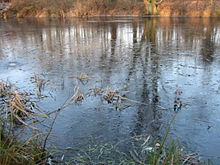Woog

As a Woog (of WAC , a Middle High German water word ) is called in parts of southwest Germany a standing water . A woog can be of natural origin or artificial.
Emergence
Natural origin
The subsoil in south-west German low mountain ranges often consists of red sandstone . This is a good aquifer that filters precipitation . The water then exits through embedded barrier layers of clay , which further seepage prevent in lowering out again. As a result, a number of moors , bog lakes and lakes have formed. These include, for example, the Ungeheuersee in the north-eastern Palatinate Forest .
Artificial creation
Primarily as water storage for the operation of mills or of Klausen , in which wood was collected for the Trift , artificial wooge were created by damming watercourses. These were also used, mostly in monasteries , as fish breeding ponds or, created from widened castle moats , as part of the city or castle fortifications , for example in St. Wendel and the Kaiserpfalz in Kaiserslautern .
The knight of Berwartstein Castle , Hans von Trotha , created a temporary woog in Wasgau in southern Palatinate when, after a long feud with the Weissenburg Monastery in 1485, he first dammed the Wieslauter near Bobenthal and then had the dam torn down again. In the small town of Weißenburg, 8 km below, it first caused a severe lack of water and then a huge flood , which is why the knight was initially banned from the Reich and later also banned from church .
The legend of the pike in the Kaiserwoog reports on an event that is said to have taken place in the aforementioned Imperial Palace of Kaiserslautern in 1497 and supposedly goes back to an event in 1230.
Occurrence of the name




The term is mainly used for waters in Rhineland-Palatinate (often in the Palatinate Forest ), but also in Saarland , in southern Hesse (mostly in the Odenwald ) and in Baden-Württemberg ( northern Baden ); The names of streets, local areas or other geographical objects can also be traced back to the waters. Examples are:
Baden-Württemberg
- Woogsee , natural remnant of the lake near Rastatt in the depression of the Kinzig-Murg-Rinne
Hesse
- At the Woogwiese , street name in Egelsbach
- Großer Woog , reservoir of the Darmbach
- Arheilger Woogstraße , street name in Darmstadt - Arheilgen
- Woogstraße , street name in Frankfurt am Main - Ginnheim
- Woogstraße , street name in Egelsbach
Rhineland-Palatinate
- Biedenbacher Woog , reservoir of the Leinbach near Frankenstein
- Büttelwoog , campsite near Dahn
- Dämmelswoog , reservoir near Fischbach
- Eiswoog , reservoir of the Eisbach near Ramsen
- Finsterthaler Woog , reservoir of the Leinbach
- Franzosenwoog , former reservoir of the Hochspeyerbach
- Gelterswoog , reservoir of tributaries of the Aschbach
- Hammerwoog , reservoir in Kaiserslautern
- Kaiserwoog , reservoir on the Kaiserpfalz in Kaiserslautern
- Kammerwoog , former reservoir of the Nahe in Idar-Oberstein, today section of the river
- Katzenwoog , reservoir of the Erlenbach near Kaiserslautern
- Kolbenwoog , reservoir of a tributary of the Aschbach
- Kranichwoog , two artificially created shallow water basins near Hütschenhausen
- Mörstadter Woog , reservoir on the northern edge of Mörstadt
- Mühlwoog , reservoir of the Leinbach shortly before its confluence with the Hochspeyerbach
- Neuhofener Woog , pond near Neuhofen
- Neuwoogbach , Bach am Neuwoogmoor
- Neuwoogmoor , nature reserve between Vogelbach and Schönenberg-Kübelberg
- Niederhausener Woog (also Niederhausener reservoir ), reservoir of the Nahe between Norheim and Niederhausen
- Pfälzerwoog (also Pfalzwoog ), reservoir of a right tributary of the Saarbach
- Salzwoog , part of Lemberg, named after a former reservoir of the Salzbach
- Scheidelberger Woog , nature reserve between Miesau and Hütschenhausen
- Schmalzwoog , reservoir with a surrounding nature reserve on the edge of Kaiserslautern
- Schweinswoog , reservoir of the Eusserbach above Eusserthal
- Seewoog , reservoir of the Leinbach near Waldleiningen
- Sixmeisterwoog , reservoir of the Aggenbach near Otterberg
- Spießwoog , reservoir near Fischbach
- Stüdenwoog , reservoir of the Eppenbrunn brook
- Vogelwoog , reservoir with surrounding nature reserve on the edge of Kaiserslautern
- Woogfelsen , natural monument at the Biedenbacher Woog near Frankenstein
- Wurzelwoog , reservoir in Kaiserslautern
- Wurzelwooggraben , Bach am Wurzelwoog
Saarland
- Alter Woog , street name in the old town of St. Wendel
- Am Altwoog , street name in the Furpach district of Neunkirchen
- Merwoog , the Lambsbach reservoir in Kirrberg created for the Merburg
- Am Merwoog , street name in Kirrberg after the aforementioned reservoir
- Möhlwoog , reservoir of the Erbach near Homburg- Jägersburg
- Wogbachtal (also Ensheimer Gelösch ), valley with reservoirs near Saarbrücken-Ensheim Airport
- Woogsackermühle , former mill on the Feilbach in Niederbexbach
- Wooggraben , tributary of the Feilbach in Bexbach
- Zum Altwoog , street name in Fürth in the Ostertal
Individual evidence
- ↑ Palatinate dictionary : Woog - 'larger standing (mostly artificially dammed) body of water, pond, pond' . tape 6 , col. 1456 .
- ↑ Wag. In: Jacob Grimm , Wilhelm Grimm (Hrsg.): German dictionary . tape 27 : W – way [twittering] -zwiesel - (XIII). S. Hirzel, Leipzig 1922, Sp. 331 ( woerterbuchnetz.de ). "Moving water, pond, backwater"
- ↑ Idylle am Woog with music and wine. (No longer available online.) In: Wormser Zeitung . July 7, 2008, formerly in the original ; Retrieved September 8, 2009 . ( Page no longer available , search in web archives ) Info: The link was automatically marked as defective. Please check the link according to the instructions and then remove this notice.
- ↑ a b Merburg and Fischweiher. Saarpfalz-Touristik, accessed on May 7, 2015 .